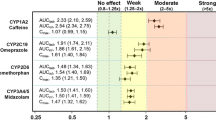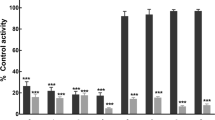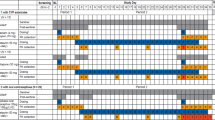Abstract
Objective
Medroxyprogesterone acetate (MPA), frequently used in contraception and chemotherapy, was involved in a report of drug-drug interaction (DDI) when co-administrated with phenytoin, doxifluridine and cyclophosphamide. In order to clarify the mechanism of such interaction, an in vitro study was undertaken to evaluate MPA’s potential to inhibit cytochrome P450 (CYP) enzymes.
Methods
Inhibitory effects of MPA on seven CYPs, including CYP1A2, CYP2A6, CYP2C8, CYP2C9, CYP2D6, CYP2E1 and CYP3A4, were conducted in human liver microsomes. Time- and NADPH-dependent inhibitions were also tested. DDI potential was predicted according to the [I]/K i value.
Results
MPA was found to inhibit CYP2C9 and CYP3A4; half inhibition concentration (IC50) was 16.1 μM and 31.5 μM, respectively. Slight inhibition was observed on CYP1A2, CYP2A6, CYP2C8 and CYP2D6 with IC50 of more than 100 μM. MPA exhibited activation rather than inhibition on CYP2E1. Further study revealed that MPA showed a noncompetitive inhibition on CYP2C9 and a competitive inhibition on CYP3A4 with K i of 9.0 μM and 36 μM, respectively. In addition, MPA was not a mechanism-based inhibitor to any of seven isoforms tested. By using predicted concentration of MPA in liver, [I]/K i was estimated to be 0.24 and 0.06 for CYP2C9 and CYP3A4, respectively. The concentration of phenytoin co-administrated with MPA was calculated to increase by 24%.
Conclusion
Based on our results, MPA can possibly cause clinically relevant DDI via the inhibition of CYP2C9.



Similar content being viewed by others
References
Cromer BA, Stager M, Bonny A, Lazebnik R, Rome E, Ziegler J, Debanne SM (2004) Depot medroxyprogesterone acetate, oral contraceptives and bone mineral density in a cohort of adolescent girls. J Adolesc Health 35:434–441
Ratchanon S, Taneepanichskul S (2000) Depot medroxyprogesterone acetate and basal serum prolactin levels in lactating women. Obstet Gynecol 96:926–928
Balkus J, Miller L (2005) Same-day administration of depot-medroxyprogesterone acetate injection: a retrospective chart review. Contraception 71:395–398
Westhoff C (2003) Depot-medroxyprogesterone acetate injection (Depo-Provera): a highly effective contraceptive option with proven long-term safety. Contraception 68:75–87
Etienne MC, Milano G, Frenay M, Renee N, Francois E, Thyss A, Schneider M, Namer M (1992) Pharmacokinetics and pharmacodynamics of medroxyprogesterone acetate in advanced breast cancer patients. J Clin Oncol 10:1176–1182
Nagasawa M, Iino Y, Koibuchi Y, Andoh T, Morishita Y (2001) Effect of a combined administration of 5-fluorouracil and medroxyprogesterone acetate on pyrimidine nucleoside phosphorylases and thymidylate synthetase in 7,12-dimethylbenz. Oncol Rep 8:543–546
Hupperets PS, Wils J, Volovics L, Schouten L, Fickers M, Bron H, Schouten HC, Jager J, Smeets J, de Jong J et al (1993) Adjuvant chemohormonal therapy with cyclophosphamide, doxorubicin and 5-fluorouracil (CAF) with or without medroxyprogesterone acetate for node-positive breast cancer patients. Ann Oncol 4:295–301
Falkson CI, Falkson G, Falkson CB, Falkson HC (1992) Mitomycin C+ high-dose medroxyprogesterone versus cyclophosphamide+doxorubicin plus fluorouracil as first-line treatment for metastatic breast cancer. Oncology 49:418–421
Konishi H, Morita K, Minouchi T, Nakajima M, Matsuda M, Yamaji A (2002) Probable metabolic interaction of doxifluridine with phenytoin. Ann Pharmacother 36:831–834
Konishi H, Yoshimoto T, Morita K, Minouchi T, Sato T, Yamaji A (2003) Depression of phenytoin metabolic capacity by 5-fluorouracil and doxifluridine in rats. J Pharm Pharmacol 55:143–149
Laine K, Yasar U, Widen J, Tybring G (2003) A screening study on the liability of eight different female sex steroids to inhibit CYP2C9, 2C19 and 3A4 activities in human liver microsomes. Pharmacol Toxicol 93:77–81
Sanderink GJ, Bournique B, Stevens J, Petry M, Martinet M (1997) Involvement of human CYP1A isoenzymes in the metabolism and drug interactions of riluzole in vitro. J Pharmaco Exp Ther 282:1465–1472
Lowry OH, Rosebrough NJ, Farr AL, Randall RJ (1951) Protein measurement with the folin phenol reagent. J Biol Clem 193:265–279
Omura T, Sato R (1964) The carbon monoxide-binding pigment of liver microsomes. J Biol Chem 239:2370–2385
Liu Y, Ma H, Zhang JW, Deng MC, Yang L (2006) Influence of ginsenoside Rh1 and F1 on human cytochrome P450 enzymes. Planta Med 72:126–131
Bachmann KA, Lewis JD (2005) Predicting inhibitory drug–drug interactions and evaluating drug interaction reports using inhibition constants. Ann Pharmacother 39:1064–1072
Ito K, Iwatsubo T, Kanamitsu S, Ueda K, Suzuki H, Sugiyama Y (1998) Prediction of pharmacokinetic alterations caused by drug-drug interactions: metabolic interaction in the liver. Pharmacol Rev 50:387–412
Bjornsson TD, Callaghan JT, Einolf HJ, Fischer V, Gan L, Grimm S, Kao J, King SP, Miwa G, Ni L, Kumar G, McLeod J, Obach SR, Roberts S, Roe A, Shah A, Snikeris F, Sullivan JT, Tweedie D, Vega JM, Walsh J, Wrighton SA, Pharmaceutical Research and Manufacturers of America Drug Metabolism/Clinical Pharmacology Technical Working Groups (2003) The conduct of in vitro and in vivo drug-drug interaction studies: a PhRMA perspective. J Clin Pharmacol 43:443–469
Tucker GT, Houston JB, Huang SM (2001) Optimizing drug development: strategies to assess drug metabolism/transporter interaction potential–towards a consensus. Br J Clin Pharmacol 52:107–117
Rautio A, Saarni HU, Arranto AJ, Stengard JH, Karki NT, Sotaniemi EA (1985) Metabolism of medroxyprogesterone acetate and hepatic drug metabolism activity. Res Commun Chem Pathol Pharmacol 47:305–308
Chotnopparatpattara P, Taneepanichskul S (2000) Use of depot medroxyprogesterone acetate in Thai adolescents. Contraception 62:137–140
Oritz A, Hiroi M, Stanczyk FZ, Goebelsmann U, Mishell DR (1977) Serum medroxyprogesterone acetate (MPA) concentrations and ovarian function following intramuscular injection of Depo-MPA. J Clin Endocrinol Metab 44:32–38
Kobayashi K, Mimura N, Fujii H, Minami H, Sasaki Y, Shimada N, Chiba K (2000) Role of human Cytochrome P450 3A4 in metabolism of medroxyprogesterone acetate. Clin Cancer Res 6:3297–3303
Mimura N, Kobayashi K, Nakamura Y, Shimada N, Hosokawa M, Chiba K (2003) Metabolism of medroxyprogesterone acetate (MPA) via CYP enzymes in vitro and effect of MPA on bleeding time in female rats in dependence on CYP activity in vivo. Life Sci 73:3201–3212
David K, Levin FJ (1979) Isolation and partial synthesis of a new metabolite of medroxyprogesterone acetate. Steroids 34:57–72
Sturm G, Haberlein H, Bauer T (1991) Mass spectrometric and high-performance liquid chromatographic studies of medroxyprogesterone acetate metabolites in human plasma. J Chromatogr 562:351–362
Vecht CJ, Wagner GL, Wilms EB (2003) Interactions between antiepileptic and chemotherapeutic drugs. Lancet Neurol 2:404–409
Ashizawa T, Ishida H, Okabe M, Gomi K (1993) Effect of medroxyprogesterone acetate on antitumor efficacies and side effect of 5-fluorouracil. Gan To Kagaku Ryoho 20:941–947
Nakamura H, Nakasa H, Ishii I, Ariyoshi N, Igarashi T, Ohmori S, Kitada M (2002) Effects of endogenous steroids on CYP3A4-mediated drug metabolism by human liver microsomes. Drug Metab Dispos 30:534–540
Torimoto N, Ishii I, Hata M, Nakamura H, Imada H, Ariyoshi N, Ohmori S, Igarashi T, Kitada M (2003) Direct interaction between substrates and endogenous steroids in the active site may change the activity of cytochrome P450 3A4. Biochemistry 42:15068–15077
Lundgren S, Kvinnsland S, Utaaker E, Bakke O, Ueland PM (1986) Effect of oral high-dose progestins on the disposition of antipyrine, digitoxin, and warfarin in patients with advanced breast cancer. Cancer Chemother Pharmacol 18:270–275
Acknowledgements
This work was supported by the 973 Program (2003CCA03400) of the Ministry of Science and Technology of China, the Leading Program (KGCXZ-SW-213-04) of Chinese Academy of Sciences and DUT-DICP Cooperation Innovation Fund. The author states that all the experiments performed strictly comply with the current laws including ethics approval of China.
Author information
Authors and Affiliations
Corresponding author
Rights and permissions
About this article
Cite this article
Zhang, JW., Liu, Y., Li, W. et al. Inhibitory effect of medroxyprogesterone acetate on human liver cytochrome P450 enzymes. Eur J Clin Pharmacol 62, 497–502 (2006). https://doi.org/10.1007/s00228-006-0128-9
Received:
Accepted:
Published:
Issue Date:
DOI: https://doi.org/10.1007/s00228-006-0128-9




